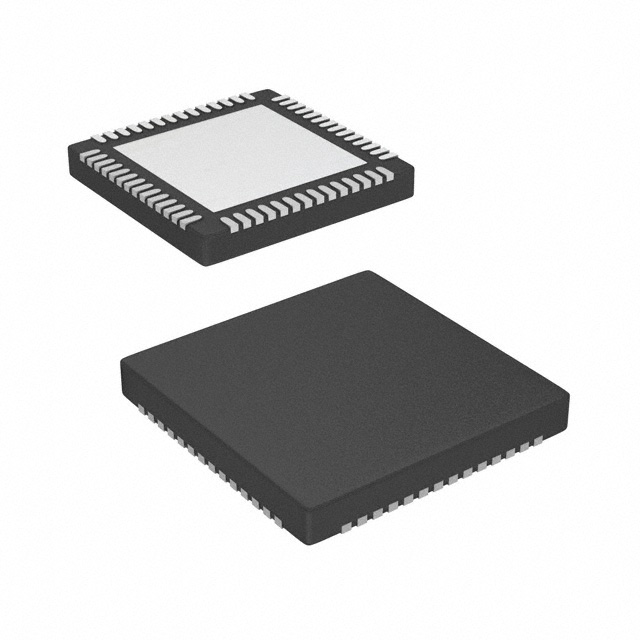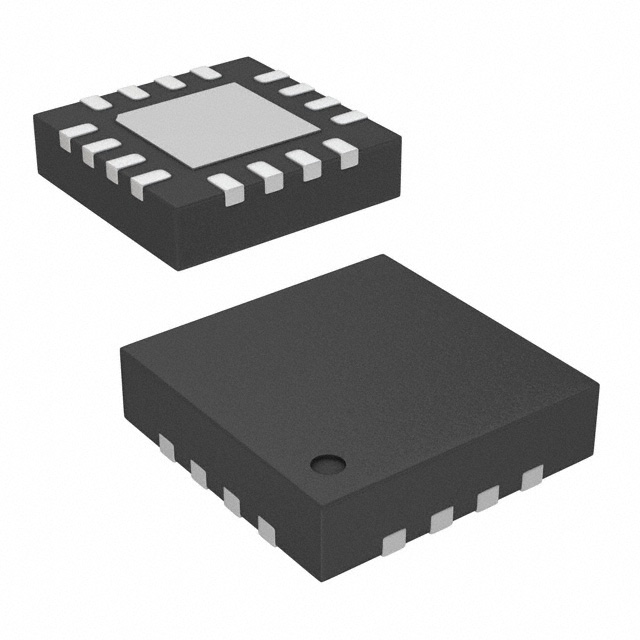ESP32-D0WDQ6 datasheet & chip | price
- Typ: TxRx + MCU
- RFFamily/Standard: Bluetooth, WiFi
- Protokoll: 802.11b/g/n, Bluetooth 4.2
- Paket: 48-VFQFN, freiliegendes Pad

KOSTENLOSE Lieferung für Bestellungen über HK$250.00

Schnelle Reaktion, schnelles Angebot

Blitzversand, keine Sorgen nach dem Verkauf

Originalkanal, Garantie der authentischen Produkte
ESP32 Guide 2024 | Choosing and Using an ESP32 Board
ESP32 development board is a microcontroller module based on ESP32 chip, widely used in IoT prototyping. In this article, we will briefly introduce its basic definition, product features, technical specifications, pinouts and commonly used expansion boards.
What is an ESP32 Development Board?
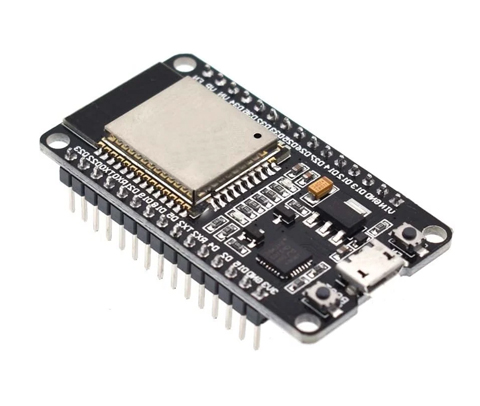
The ESP32 development board is a high-performance, general-purpose microcontroller module with integrated Wi-Fi, Bluetooth and low-power Bluetooth (BLE), which is widely used in wireless sensor networks, voice recognition, audio playback, MP3 decoding, etc. The board is based on the ESP32-D0WDQ6 chip, with a dual-core 32-bit Xtensa® LX6 processor running independently.
The development board is based on the ESP32-D0WDQ6 chip as the core, built-in dual-core 32-bit Xtensa® LX6 processor, which can run independently, with a maximum computational performance of up to 600 MIPS, and the main frequency can be dynamically adjusted from 80 MHz to 240 MHz, realizing a flexible balance between performance and power consumption.
For storage, the onboard 448 KB ROM, 520 KB SRAM, 16 KB RTC low-power memory, and 4 MB SPI Flash are used for program and data storage. In standby mode, the main CPU can be turned off and only the low-power co-processor can be enabled to continuously monitor analog signals or external sensors, thus effectively extending battery life.
The ESP32 architecture supports a rich set of peripheral interfaces including GPIOs, ADCs, DACs, UARTs, I2Cs, SPIs, I2Ss, and PWMs, as well as integrating capacitive touch sensors, Hall sensors, an SD card interface, and an ISO11898-1-compliant TWAI bus (CAN bus) interface. The board offers a flexible GPIO pinout, allowing you to control a variety of external devices and further expand functionality with a 30Pin or 38Pin expansion board.
Product Features
– Onboard CP2102 stable USB to TTL chip to ensure normal serial communication
– Supports automatic download, no need to manually switch between download and run modes
– Adopts immersed gold process to enhance durability and oxidation resistance
– Compatible with Windows (including Cygwin and MSYS32 environment) and Linux development environment
– Supports Arduino IDE for rapid development and C++ programming.
Product Specification
| Kategorie | Item | Product Specification |
|---|---|---|
| Certification | RF Certification | FCC/CE-RED/IC/TEL EC/KCC/SRRC/NCC |
| WiFi Certification | Wi-Fi Alliance | |
| Bluetooth Certification | BQB | |
| Environmental Certification | RoHS/REACH | |
| Testing | Zuverlässigkeit | HTOL/HTSL/UHAST/TCT/ESD |
| Wi-Fi | Protocol | 802.11 b/g/n (802.11n, rate up to 150 Mbps) |
| A-MPDU and A-MSDU aggregation, with 0.4 µs guard interval | ||
| Frequency Range | 2.4 GHz–2.5 GHz | |
| Bluetooth | Protocol | Complies with Bluetooth 4.2/BR/EDR and BLE standards |
| Radiofrequenz | -97 dBm sensitivity with NZIF receiver | |
| Class-1, Class-2, Class-3 transmitters | ||
| AFH | ||
| Audio | CVSD and SBC audio | |
| Hardware | Module Interface | SD card, UART, SPI, SDIO, PC, LED PWM, Motor PWM, I2S, IR pulse counter, GPIO, capacitive touch sensor, ADC, DAC, dual-wire automotive bus (TWA1, ISO11898-1 compatible) |
| On-chip Sensor | Hall sensor | |
| Integrated Crystal | 40 MHz crystal oscillator | |
| Integrated SPI Flash | 4 MB | |
| Betriebsspannung | 3.0 V–3.6 V | |
| Operating Current | Average: 80 mA | |
| Power Supply Current | Max: 500 mA | |
| Betriebstemperatur | -40°C bis +85°C | |
| Package Dimensions | (18.00 ± 0.10) mm × (25.50 ± 0.10) mm × (3.10 ± 0.10) mm | |
| Moisture Sensitivity Level (MSL) | Level 3 |
ESP32 Pinout Reference & Expansion Board
DOIT ESP32 Development Board | ESP-WROOM-32D Module | CP2102 | Micro-USB | Pre-Soldered Headers
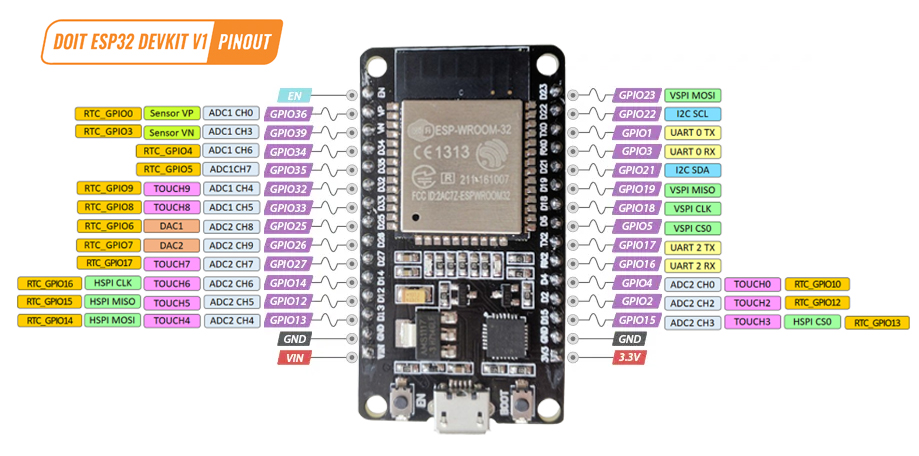
DOIT ESP32 DEVKIT v1 Pinout Diagram
Pin Definitions
| Name | Stift | Typ | Funktion |
|---|---|---|---|
| Masse | 1 | P | Boden |
| 3V3 | 2 | P | Stromversorgung |
| EN | 3 | ICH | Enable: active high |
| SENSOR_VP | 4 | ICH | GPIO36, ADC1_CH0, RTC_GPIO0 |
| SENSOR_VN | 5 | ICH | GPIO39, ADC1_CH3, RTC_GPIO3 |
| IO34 | 6 | ICH | GPIO34, ADC1_CH6, RTC_GPIO4 |
| IO35 | 7 | ICH | GPIO35, ADC1_CH7, RTC_GPIO5 |
| IO32 | 8 | I/O | GPIO32, XTAL_32K_P, ADC1_CH4, TOUCH9, RTC_GPIO9 |
| IO33 | 9 | I/O | GPIO33, XTAL_32K_N, ADC1_CH5, TOUCH8, RTC_GPIO8 |
| IO25 | 10 | I/O | GPIO25, DAC_1, ADC2_CH8, RTC_GPIO6, EMAC_RXD0 |
| IO26 | 11 | I/O | GPIO26, DAC_2, ADC2_CH9, RTC_GPIO7, EMAC_RXD1 |
| IO27 | 12 | I/O | GPIO27, ADC2_CH7, TOUCH7, RTC_GPIO17, EMAC_RX_DV |
| IO14 | 13 | I/O | GPIO14, ADC2_CH6, TOUCH6, RTC_GPIO16, MTMS, HSPI_CLK, HS2_CLK, SD_CLK, EMAC_TXD2 |
| IO12 | 14 | I/O | GPIO12, ADC2_CH5, TOUCH5, RTC_GPIO15, MTDI, HSPI_Q, HS2_DATA2, SD_DATA2, EMAC_TXD3 |
| Masse | 15 | P | Boden |
| IO13 | 16 | I/O | GPIO13, ADC2_CH4, TOUCH4, RTC_GPIO14, MTCK, HSPI_D, HS2_DATA3, SD_DATA3, EMAC_RX_ER |
| SHD/SD2* | 17 | I/O | GPIO9, SD_DATA2, SPI_HD, HS1_DATA2, U1RXD |
| SWP/SD3* | 18 | I/O | GPIO10, SD_DATA3, SPI_WP, HS1_DATA3, U1TXD |
| SCS/CMD* | 19 | I/O | GPIO11, SD_CMD, SPI_CS0, HS1_CMD, U1RTS |
| SCK/CLK* | 20 | I/O | GPIO6, SD_CLK, SPI_CLK, HS1_CLK, U1CTS |
| SDO/SD0* | 21 | I/O | GPIO7, SD_DATA0, SPI_Q, HS1_DATA0, U2RTS |
| SDI/SD1* | 22 | I/O | GPIO8, SD_DATA1, SPI_D, HS1_DATA1, U2CTS |
| IO15 | 23 | I/O | GPIO15, ADC2_CH3, TOUCH3, MTDO, HSPICSO, RTC_GPIO13, HS2_CMD, SD_CMD, EMAC_RXD3 |
| IO2 | 24 | I/O | GPIO2, ADC2_CH2, TOUCH2, RTC_GPIO12, HSPWP, HS2_DATA0, SD_DATA0 |
| IO0 | 25 | I/O | GPIO0, ADC2_CH1, TOUCH1, RTC_GPIO11, CLK_OUT1, EMAC_TX_CLK |
| IO4 | 26 | I/O | GPIO4, ADC2_CH0, TOUCH0, RTC_GPIO10, HSPI_HD, HS2_DATA1, SD_DATA1, EMAC_TX_ER |
ESP32 Development Board with Type-C | CH340 USB to Serial | Espressif Systems
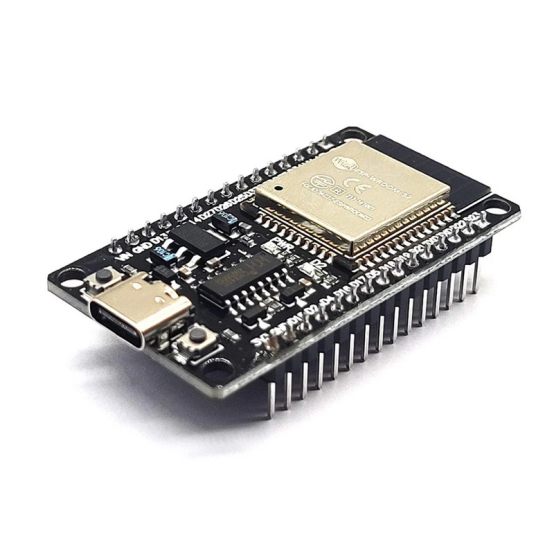
Module Model: ESP32
Host Controller: ESP32-D0WDQ6-V3, Dual-core 32-bit MCU
Wireless Communication: Integrated Wi-Fi and Bluetooth
On-chip Memory: 520 KB SRAM, 448 KB ROM, 16 KB RTC SRAM
External Memory: On-board 4 MB Flash
USB to Serial Chip: CH340C Strong compatibility, stable and fast download
Pinout: Soldered row of pins, suitable for breadboarding and rapid development.
Power supply method
supports three kinds of power supply methods:
VIN pin input (recommended 5V, maximum support 5.5V battery input)
USB Type-C interface power supply
3.3V external power input
Supported Software Platforms
Arduino IDE
Mixly Graphical Programming Environment
Mind+ Education Platform
Python / MicroPython Development Environment

ESP32 Dev Board CH340-USB-C Pinout
Pin Description Diagram (key notes in the diagram)
Reset (EN): reset button, used to reboot the ESP32 module.
BOOT (IO0): Download button, used to enter firmware download mode.
Type-C connector: Used for USB connection, can be used as power input or serial communication interface between ESP32 module and PC.
To enter the “Firmware Download” mode, the operation steps are as follows:
Press and hold the BOOT key (don’t let go), then press the Reset key briefly, and then let go of the BOOT key, then the ESP32 will enter the UART download mode, and you can download the firmware through the serial tool.
ESP32 38Pin Expansion Board

Product Parameters
This expansion board is safe and reliable for a wide range of ESP32 applications.
With a total of 38 pins on board, it has stronger expansion capability than traditional 30-pin ESP32 modules.
Narrow design, compatible with a variety of board layouts; support for Lua development environment, to facilitate rapid development.
Features
– GPIO 1 in 2 Expansion: Expand each GPIO pin of the ESP32 development board to two, which is easy to reuse pin resources, ideal for smart home and other multi-pin applications, and an excellent alternative to breadboards.
Connection type: supports row of pins and screw terminals, which can be chosen flexibly according to the actual needs.
– Double-layer PCB design: Each pin is connected to both sides of the board to enhance signal stability and avoid poor contact and transmission interference.
– Plug and play version: The board is fully soldered, no need for users to solder components, ready to use out of the box, improving development efficiency.
Compatibility Note
is only compatible with ESP32 development boards with narrow pin holes and versions without mounting holes, and is not applicable to other versions (e.g., wide-body, development boards with mounting holes, etc.).
ESP32 30Pin Expansion Board (Black)

Features
This expansion board is designed for ESP32 development boards with 15 pins on each side (30 pins in total), and it can completely pin out all IO interfaces.
Each IO pin is equipped with independent positive and negative power supply pins, which makes it easy to connect various sensors and modules directly and realize fast and simple wiring operation.
The board supports three types of power supply: DC round hole power socket, microUSB interface, and Type-C interface, which provides greater flexibility in power access during the development process.
ESP32 38Pin Universal Expansion Board (purple)

Interface Description
①Power indicator (PWR): indicates the status of on-board power supply
②USB power supply interface (5V): power supply for the system via USB
③DC power supply interface (6.5-16V): supports wide-voltage DC power supply
④I2C expansion interfaces (2 sets): facilitates the connection of I2C devices
⑤IO expansion interface (GVS): leads out all the pins of ESP32, and is equipped with three interfaces, G (GND), V (VCC), and S (signal), suitable for sensor modules
⑥Development board fixed hole: for mounting the ESP32 development board
⑦ 5V / 3.3V voltage output interface: providing stable power supply for the peripheral devices
⑧ Voltage selection jumper interface: selecting the power supply voltage to be 5V or 3.3V through the Jumper
Features
Safe and reliable, applicable to a variety of ESP32 project development scenarios
Single-side double-row female design, compatible with most 38Pin ESP32 development boards
High-quality PCB materials, signal stability and durability
Provides three power supply modes: Type-C, Micro USB, and DC power supply holder
Also supports power supply and firmware burning for the development board through the on-board power supply expansion port
High adaptability Highly adaptable, easy to reuse all pins in DIY, education, IoT and other projects.
Abschluss
Whether you’re building a sensor network, conducting automation experiments, or prototyping an IoT device, ESP32 development boards give you the flexibility and scalability you need. Explore compatible expansion boards to start your next project today.














